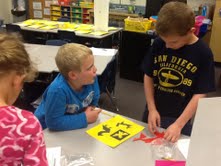Six Key Ideas
·
More Freedom
o
During
reading circles, allow them to have discussions. Do not organize all
conversations and roles/activities.
§ When I do reading circles in class, I
assign each student a role. I tell them what their “job” is during this time. I
provide questions and usually guide the conversation. I would like to give them
the freedom to discuss their story with less formality. I will model how a
reading circle looks and the possible discussions before we leap into it. I
think that I will let them pick their roles more frequently. I would like them
to experience each role, so I need to find a way to do this without being in
control at all times. I want reading circles to feel inviting and fun.
·
Effective teachers set aside a time
for individual silent reading each day.
o
I
have always thought that I was being lazy when I assigned independent reading
time. I very rarely get this in during a regular school week. After reading
this chapter, I discovered that students need time to read independently. Most
of my students come from homes that value education. I would say that 90% of my
kids are very loyal readers. In second grade we require the kids to read at
least 20 minutes each night. To receive the top score on their reading minute’s
sheets, they must read 40 minutes each school night. About half of the kids in
my class reach the 40 minute goal.
o
Next
year I plan on finding more time for independent reading during school. I also
liked that the chapter suggested that some kids will share books and discuss
what they are reading. When we have independent reading time, I always tell
them they need their own books and that the room must remain silent. I need to
allow the kids to share and enjoy their book discussions. I will monitor this
closely, so I know that they are discussing books. J
·
Kids need easy, “beach books.”
o
I
level my kids during guided reading or reading circle time. I usually provide
books that are a little bit higher than their level. I thought that I was
pushing them towards higher level vocabulary. I would like to try reading
circles with “beach books.” I might discover that the discussions are much richer,
because they fully comprehend what they are reading.
·
Choice Books
o
Next
year, I want to provide more opportunities for the students to pick their
selections. I usually have three different books at one time. They are usually
leveled for each group. I would like to continue to level books, but allow some
student choice as well.
·
Scavenger Hunt the Stories
o
I
love this strategy! This would be a great way to address the grammar skills for
each week. We could have a scavenger hunt to identify our spelling skills each
week. We could also search for similes, metaphors, verbs and so on. I think
that I will try this tomorrow with contractions. This is another strategy that
is beneficial for all levels of learners.
·
Teacher Modeling and discussing the
reading process
o
I
want to try this! This would be a great way for kids to see how someone else
thinks while they read. When next year starts, I will model the reading process
with almost everything I read. This will be a great way to introduce my
students to literature circles. They will then know what to think about and
what to discuss. Hopefully my kids will catch on to what goes through a
person’s head when they read.


